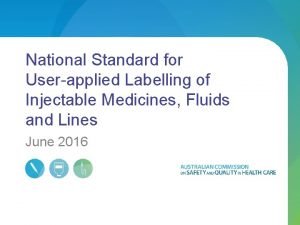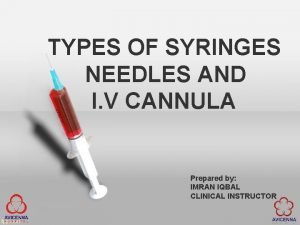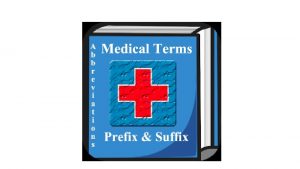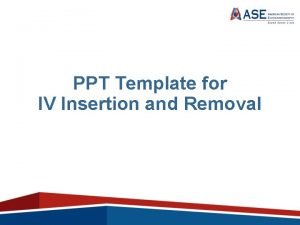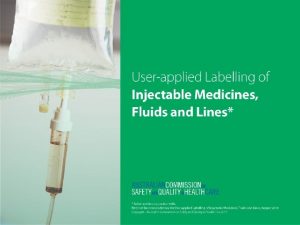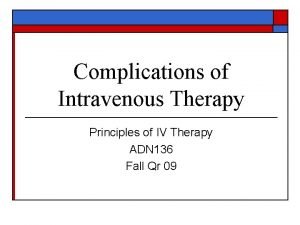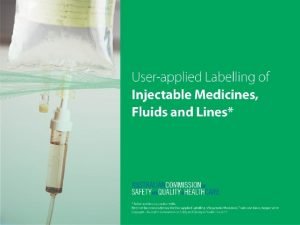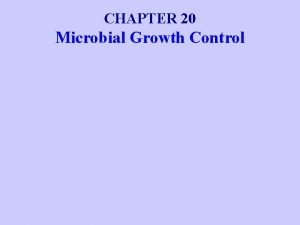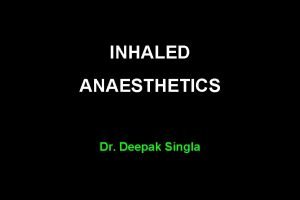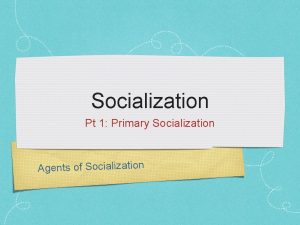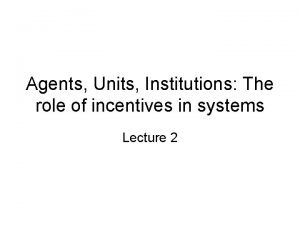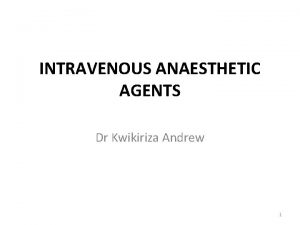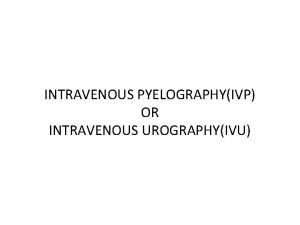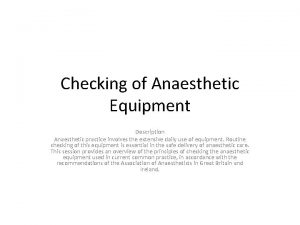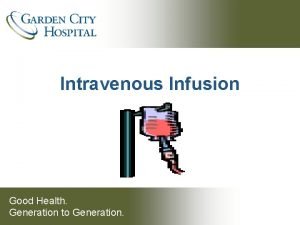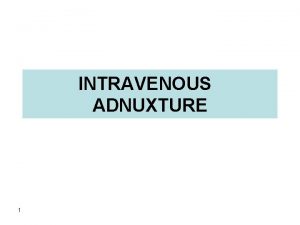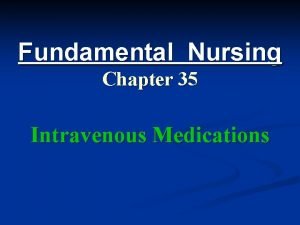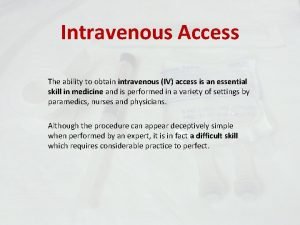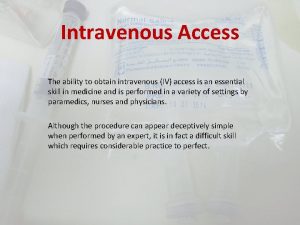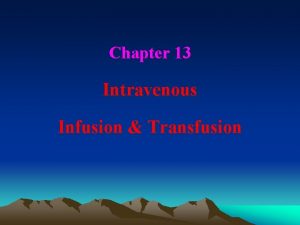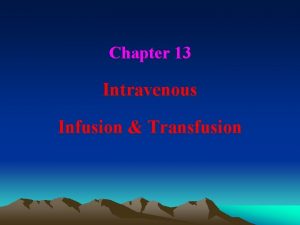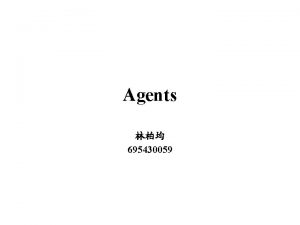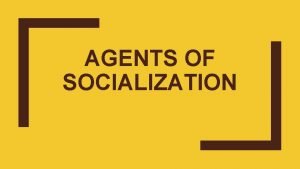Intravenous Anaesthetic Agents Uses of I V anaesthetic















- Slides: 15

Intravenous Anaesthetic Agents

Uses of I. V. anaesthetic agents • (1) Induce anaesthesia, are commonly used to induce anaesthesia, as induction is usually more rapid and smoother than that associated with inhalational agents. • (2) Maintenance of anaesthesia, either alone or in combination with. N 2 O, they may be administered as repeated bolus doses or by continuous I. V. infusion. • (3) Sedation during regional anaesthesia. • (4) Sedation in the intensive therapy unit (I. T. U. ). • (5) Treatment of status epilepticus.

Properties of the ideal I. V. anaesthetic agents (1) Rapid onset. (2) Rapid recovery. (3) Analgesia at subanaesthetic concentrations. (3) Minimal cardiovascular and respiratory depression. (5) No emetic effects. (6) No excitatory phenomena (e. g. coughing, hiccup, involuntary movement) on induction. • (7) No emergence phenomena (e. g. nightmares). • (8) No interaction with neuromuscular blocking drugs. • (9) No pain on injection. • • •

Con… • • (10) No venous sequelae. (11) Safe if injected inadvertently into an artery. (12) No toxic effects on other organs. (13) No release of histamine. (14) No hypersensitivity reactions. (15) Water soluble formulation. (16) Long shelf life. (17) No stimulation of porphyria.

Thiopentone • Is supplied in vials of 0. 5 gm. Or 1 gm. Which are made up into a 2. 5% solution. The usual induction dose is 4 -5 mg/Kg. • CNS effects: • Produce anaesthesia usually in less than thirty seconds after I. V. injection. The hypnotic action is potent, but its analgesic effect is poor. Consciousness is usually regained in 5 -10 min. Thiopentone is a very potent anticonvulsant.

pharmacology • CVS effect: • Myocardial contractility is depressed and peripheral vasodilatation occurs. Arterial pressure decreases, and profound hypotension may occur in the patients with hypovolaemia or cardiac disease.

Con… • RS: • Ventilatory drive is decreased as a result of reduced sensitivity of the respiratory center to CO 2. A short period of apnea is common, assisted or controlled ventilation may be required. There is an increase in bronchial muscle tone, although frank bronchospasm is uncommon. Laryngospasm may be precipitated by surgical stimulation or the presence of secretions, blood or foreign bodies (e. g. an oropharyngeal or laryngeal mask airway) in the pharynx or larynx.

Con… • Skeletal muscle: • There is poor muscle relaxation and movement in response to surgical stimulation is common. • Pregnant uterus and placenta: • There is little effect on resting uterine tone. Crosses the placenta readily, although fetal blood concentrations do not reach the same levels as those observed in the mother.

Con… • Adverse effects: • (1) Hypotension: The risk is increased if excessive doses are used, or if Thiopentone is administered to hypovolemic, shocked or previously hypertensive patients. Hypotension is minimized by administering the drug slowly. Thiopentone should not be administered to patients in the sitting position. • (2) Respiratory depression: The risk is increased if excessive doses are used, or opioid drugs have been administered. Facilities must be available to provide artificial ventilation. • (3) Tissue necrosis: Local necrosis may follow extravasation. Median nerve damage may occur after extravasation in the antecubital fossa, and this site is not recommended for peripheral I. V. cannulation in anaesthesia.

Con… • • • (4) Accidental intra-arterial injection: This is usually the result of inadvertent injection into the brachial artery or aberrant ulnar artery in the antecubital fossa. The patient usually complains of intense burning pain, and this is an indication to stop injecting the drug immediately. The forearm and hand may become blanched and blisters may appear distally. Intra-arterial Thiopentone causes profound constriction of the artery accompanied by local release of noradrenaline. In addition, crystals of Thiopentone form in the arterioles. In combination with thrombosis caused by endarteritis, adenosine triphosphate release from damaged red cells and aggregation of platelets, these result in emboli and may cause ischemia or gangrene in parts of the forearm, hand or fingers. The needle should be left in the artery and a vasodilator (e. g. papaverine 20 mg. ) administered. Stellate ganglion or brachial plexus block may reduce arterial spasm. Heparin should be given I. V. and oral anticoagulants should be prescribed after operation. The risk of ischemic damage after intra-arterial injection is much greater if a 5% solution of Thiopentone is used, so 2. 5% is the recommended concentration.

Con… • (5) Laryngospasm. • (6) Bronchospasm: This is unusual, but may be precipitated in asthmatic patients. • (7) Allergic reactions: These range from cutaneous rashes to severe or fatal anaphylactic or anaphylactiod reactions with cardiovascular collapse. Severe reactions are rare (approximately 1 in 14 -20 000). • (8) Thrombophlebitis: This is relatively uncommon, unless the 5% solution is used.

indications • (1) Induction of anaesthesia. • (2) Maintenance of anaesthesia: Thiopentone is only suitable for short procedures because accumulation occurs with repeated doses. • (3) Basal narcosis by rectal administration. • (4) Treatment of status epilepticus. • (5) Reduction of intracranial pressure.

contraindications • Absolute contraindications: • (1) Airway obstruction: Intravenous anaesthesia should not be employed if there is anticipated difficulty in maintaining an adequate airway, e. g. epiglottitis, oral or pharyngeal tumors. • (2) Porphyria: Barbiturates may precipitate lower motor neuron paralysis or severe cardiovascular collapse in patients with porphyria. • (3) Previous hypersensitivity reaction.

precautions special care is needed when Thiopentone is administered in the following circumstances: • (1) Cardiovascular disease. Patients with hypovolaemia, myocardial disease, cardiac valvular stenosis or constrictive pericarditis are particularly sensitive to the hypotensive effects of Thiopentone. However, if the drug is administered with extreme caution, it is probably not more hazardous than other I. V. anaesthetic agents. • (2) Severe hepatic disease. Reduced protein binding results in higher concentrations of free drug. Metabolism may be impaired. A normal dose may be administered, but very slowly. • (3) Renal disease. In chronic renal failure, protein binding is reduced. A normal dose may be administered, but very slowly. • (4) Muscle disease. Respiratory depression is exaggerated in patients with myasthenia gravis or dystrophia myotonica.

Con… • (5) Reduced metabolic rate. Patients with myxoedema are exquisitely sensitive to the effects of Thiopentone. • (6) Obstetric. An adequate dose must be given to ensure that the mother is anaesthetized. However, excessive doses may result in respiratory or cardiovascular depression of neonate in C. S. • (7) Outpatient anaesthesia. Early recovery is slow in comparison with other agents (propofol). This is seldom important unless rapid return of airway reflexes is essential, e. g. after oral or dental surgery. However, slow elimination of Thiopentone may result in persistent drowsiness for 24 -36 h, and this impair the ability to drive or use machinery. There is also potentiation of the effect of alcohol or sedative drugs ingested during that period. • (8) Adrenocortical insufficiency. • (9) Extremes of age. • (10) Asthma.
 National standard for user applied labelling
National standard for user applied labelling Injectable medication administration pretest
Injectable medication administration pretest Types of injection
Types of injection Intravenous combining vowel
Intravenous combining vowel Iv cannulation ppt
Iv cannulation ppt Iv cannula labelling
Iv cannula labelling Complications of intravenous therapy
Complications of intravenous therapy Line & catheter label - intravenous burette
Line & catheter label - intravenous burette Blood administration pretest
Blood administration pretest Physical antimicrobial agents
Physical antimicrobial agents Mac isoflurane
Mac isoflurane 3 examples of drop batters
3 examples of drop batters Hydrolysis of feldspar
Hydrolysis of feldspar Structure of intelligent agents
Structure of intelligent agents Agents of socialization
Agents of socialization Role of economic agents
Role of economic agents
